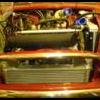An Experimental Alloy A Series, Made By BMC
"In the late 1950's BMC realised that their "Workhorse" engine the A series could do with a bit of a face lift. To this end they commissioned The British Aluminium Co. to investigate the possibilities of making an all Alloy A Series. This project was overseen by George Harriman with input from other BMC worthies including Issigonis. By 1963 "BA" had produced a number of these blocks in varying configurations, with blocks actually running in at least 1 Riley Elf and the project looked like it was going to go somewhere."
More details and photos in links below:-
http://mk1-performan...mental_dept.htm
http://mk1-performan...lock-report.pdf
http://mk1-performan...loy_block_2.JPG
Read of earlier all-alloy A-Series attempts in both Barry Sharrett's Post-War Baby Austins and Graham Robson's A-Series books.
Using the experimental all-alloy 998cc prototype engine as a rough guide, perhaps it is possible to roughly calculate the weight of the 1098-1275cc engines had the latter been all-alloy?
The PDF mentions the weight of the 998cc iron block is 84lbs / 38kg, while the all-alloy version was 29lbs / 13kg (including 8lbs of iron cylinder liners). It also states that previous all-alloy A-Series attempts at using aluminum for iron reduces the weight by half, so in theory about 60kg for an all-alloy 1275cc assuming the latter's approximate figure of 120kg is accurate and potentially competitive against the following:
Rootes Imp engine = 176lb / 79.8kg
Reliant OHV = 136lb / 62.6kg (non-alloy prototype being roughly 186-196 lb / 85.2-89.8kg)
Standard-Triumph SC 1300/1500 = roughly 100-135kg (floppy crank units)
Issigonis 9X = 200lb / 90.7kg
K-Series = 96.5kg (figures seem to vary)
Fiat 100 Series = roughly 100-110kg (other sources to say about 108kg)
A-Series = roughly 120kg
A-Series (all-alloy) = roughly 60kg
Edited by Mite, 19 July 2019 - 03:08 AM.
















